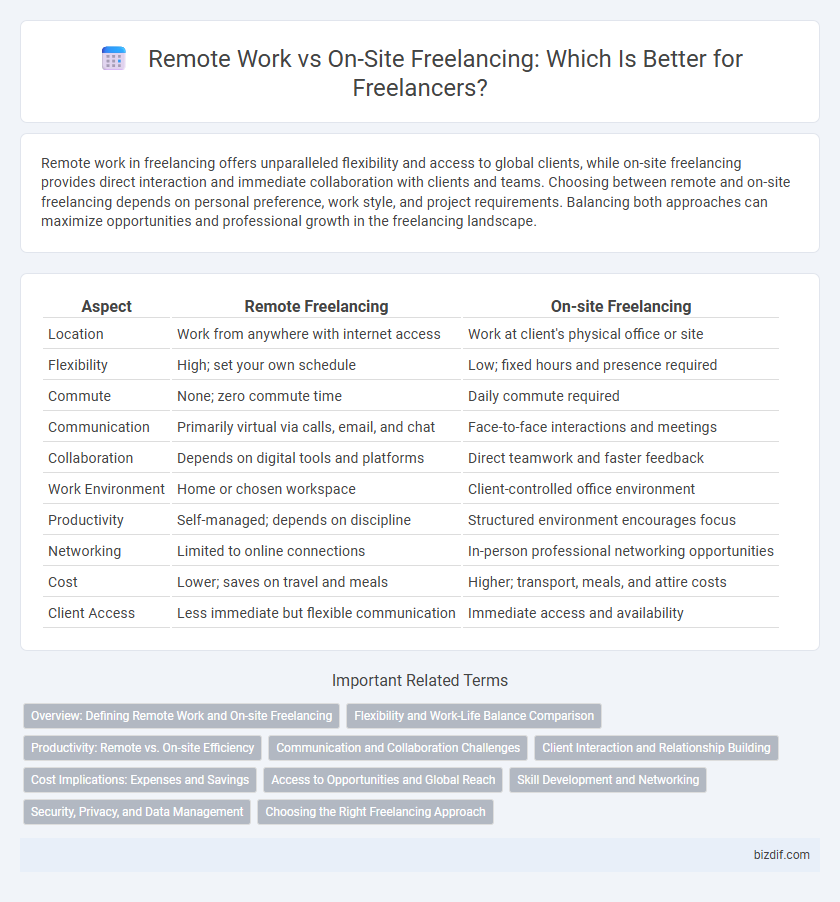Remote work in freelancing offers unparalleled flexibility and access to global clients, while on-site freelancing provides direct interaction and immediate collaboration with clients and teams. Choosing between remote and on-site freelancing depends on personal preference, work style, and project requirements. Balancing both approaches can maximize opportunities and professional growth in the freelancing landscape.
Table of Comparison
| Aspect | Remote Freelancing | On-site Freelancing |
|---|---|---|
| Location | Work from anywhere with internet access | Work at client's physical office or site |
| Flexibility | High; set your own schedule | Low; fixed hours and presence required |
| Commute | None; zero commute time | Daily commute required |
| Communication | Primarily virtual via calls, email, and chat | Face-to-face interactions and meetings |
| Collaboration | Depends on digital tools and platforms | Direct teamwork and faster feedback |
| Work Environment | Home or chosen workspace | Client-controlled office environment |
| Productivity | Self-managed; depends on discipline | Structured environment encourages focus |
| Networking | Limited to online connections | In-person professional networking opportunities |
| Cost | Lower; saves on travel and meals | Higher; transport, meals, and attire costs |
| Client Access | Less immediate but flexible communication | Immediate access and availability |
Overview: Defining Remote Work and On-site Freelancing
Remote work in freelancing refers to performing tasks from any location outside the client's physical office, leveraging digital communication tools for collaboration. On-site freelancing requires the freelancer to be physically present at the client's workplace, facilitating direct interaction and immediate access to resources. Both models demand distinct management styles and impact workflow, communication, and project execution differently.
Flexibility and Work-Life Balance Comparison
Remote freelancing offers greater flexibility by allowing professionals to set their own schedules and work from anywhere, enhancing work-life balance through reduced commuting time and customizable work environments. On-site freelancing provides structured hours and face-to-face collaboration, which can benefit those who prefer clear boundaries between work and personal life but may limit flexibility. Studies indicate remote freelancers report higher satisfaction with work-life balance due to adaptable hours and location independence.
Productivity: Remote vs. On-site Efficiency
Remote freelancing often enhances productivity through fewer workplace distractions and flexible scheduling, enabling focused work sessions tailored to individual peak performance times. On-site freelancing provides structured environments and immediate team collaboration, which can boost efficiency for tasks requiring real-time communication and quick feedback. Choosing between remote and on-site depends on job nature, personal work habits, and the need for direct team interaction to maximize overall productivity.
Communication and Collaboration Challenges
Remote work in freelancing often faces communication delays due to time zone differences and reliance on digital tools, which can hinder real-time collaboration compared to on-site freelancing. On-site freelancers benefit from face-to-face interactions, enabling immediate feedback and smoother teamwork, reducing misunderstandings. Effective communication platforms and structured meeting schedules are essential to bridge collaboration gaps in remote freelancing environments.
Client Interaction and Relationship Building
Remote work in freelancing enables flexible and diverse client interactions through digital communication tools, fostering global networking opportunities and efficient project updates. On-site freelancing facilitates face-to-face meetings, enhancing trust-building, immediate feedback, and stronger rapport with clients. Effective client relationship building in freelancing depends on balancing communication methods to meet project needs and client preferences.
Cost Implications: Expenses and Savings
Remote freelancing significantly reduces costs related to commuting, office attire, and daily meals, leading to substantial savings on transportation and work-related expenses. On-site freelancing often incurs higher costs due to commuting fares, parking fees, and the need for professional wardrobe maintenance. Budgeting for remote work typically centers around reliable internet, home office equipment, and utility bills, which are generally lower than the cumulative expenses of on-site freelancing.
Access to Opportunities and Global Reach
Remote freelancing expands access to diverse projects by connecting professionals with clients worldwide, removing geographical barriers and increasing the pool of potential opportunities. On-site freelancing often limits access to local markets, restricting exposure to global clients and reducing chances for international collaboration. Embracing remote work enhances global reach, enabling freelancers to build a dynamic portfolio across various industries and cultural contexts.
Skill Development and Networking
Remote work in freelancing enhances skill development through exposure to diverse clients and projects across global markets, fostering adaptability and specialized expertise. On-site freelancing offers immediate networking opportunities with local professionals, enabling face-to-face collaboration and faster relationship building. Combining remote and on-site work maximizes both skill growth and meaningful professional connections.
Security, Privacy, and Data Management
Remote freelancing often involves increased risks related to data security and privacy due to reliance on internet connections and cloud-based tools, necessitating rigorous encryption and secure VPN use. On-site freelancing offers greater control over physical data management and limits exposure to cyber threats but may restrict flexibility and requires dedicated infrastructure. Effective security policies and privacy protocols must be tailored to each environment to safeguard client information and ensure compliance with data protection regulations like GDPR or CCPA.
Choosing the Right Freelancing Approach
Choosing the right freelancing approach depends on project requirements, personal work style, and client preferences. Remote work offers flexibility and access to a global client base, while on-site freelancing fosters direct collaboration and immediate feedback. Evaluating communication needs, deadlines, and technical resources ensures optimal productivity and job satisfaction.
Remote Work vs On-site Freelancing Infographic

 bizdif.com
bizdif.com